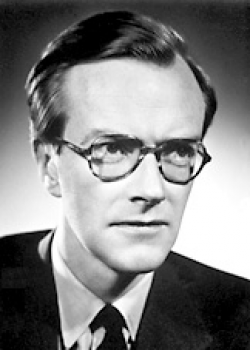Maurice Wilkins

- Born
- 15 December 1916
- Died
- 5 October 2004 (age 87)
Maurice Wilkins is best known for producing the first image of DNA fibres which contributed to the Watson and Crick double-helix model.
Maurice Wilkins was born in Pangaroa in New Zealand. His family moved to England when he was a child, and he went on to study Physics at the University of Cambridge, St John’s College, graduating in 1938. He then studied for a PhD at the University of Birmingham in 1940, investigating the thermal stability of trapped electrons in phosphors, and the theory of phosphorescence.
Wilkins applied his knowledge in this area to several war-time problems, such as the improvement of cathode ray tube screens for radar.
After his PhD, he went onto work with Professor M L E Oliphant, where he investigated mass spectrograph separation of uranium isotopes, to use in bombs. He was recruited to work on the Manhattan Project in California, where the atomic bomb was being developed, where he focused on isotope uses. However this wasn’t what Wilkins wanted to work on so he moved to continue research at St. Andrews’ University in Scotland.
In 1945, he became a lecturer in physics at the University of St Andrews, where he started to research biophysics. Along with John Randall in Scotland, he researched molecular structures by using x-ray patterns. The pair’s work took them to King’s College London, and Wilkins joined the newly formed Medical Research Council Biophysics Research Unit. He was able to attain the first x-ray diffraction of deoxyribonucleic acid fibres, which led to the production of the first image of molecular DNA strands.
In 1951, Rosalind Franklin took up a position at the unit and generated newer data on DNA. Wilkins showed Watson an image that Franklin had taken, and this made Watson realised that DNA should have a double helix. He and Crick used this image, along with additional information to support the theory of DNA having a helical structure. Their theory was published in 1953.
Wilkins shared the 1962 Nobel Prize in Physiology or Medicine with Watson and Crick, however Rosalind Franklin died in 1958, aged 37, and so could not be awarded the Nobel Prize.
Wilkins was elected as a fellow of the Royal Society in 1959, and was awarded the Albert Lasker Award (shared with Watson and Crick) by the American Public Health Association in 1960. He was made Companion of the British Empire in 1962.
I mean, the general rule is if you're not prepared to make a mistake, you're not going to make much progress.
One year before his death, and in celebration of the 50-year anniversary of the double helix discovery, Wilkins published an autobiography entitled ‘The third man of the Double Helix’.



